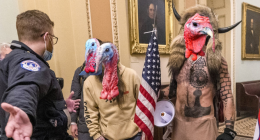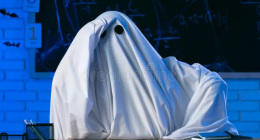Founded when the university itself began in 1892, The Stanford Daily has long existed as Stanford students’ first recourse for news branching across world affairs, university life, sports and culture. From its very beginnings, the paper has broken important news stories and acted as the first bastion of information to generations and generations of students. The Stanford Flipside spoke to current staffers of the paper to find out more about the long history of this noble institution.
Chapter 1: The Beginning
Mike Waldrom (current editor-in-chief): From the very beginning, the Daily was a paper by the people, for the people. Back in 1892, that was a credo to live by. In fact, when Horace Squall, the Daily’s first EIC, founded the power, those were the first words he ever said.
‘By the people, for the people.’
Richie Daws (op-ed columnist): Squall was a man of great integrity. He lived by those words. And when he spewed them forth, gestating a sodden lump of paper from out of the depths of his lizard-throat, those were the words written on that paper.
Hayley Montrose (record-keeper): The records show that many people were impressed with his gesture. The books show the cries of his fellow founders: “Ah, my eyes, the lizard-mucus burns my eyes!” “What have you done, Squall, you madman!” “I feel nothing but burning!” Those were the shouts of our leaders.
Strong leaders.
Waldrom: As a result, the original editorial board of the Daily was completely blind. And we try to keep that journalistic spirit alive to this very day.
Madeline Gall (Arts and Life Editor): Squall was the editor for the first twenty years of the paper, his lizard-skin keeping him remarkably hearty and undamaged by the passage of time. In fact, it took twenty men to drag him from the office on his final day of publication.
Daws: Eighteen men died that day. The others you can see on our ‘Wall of Heroes.’
Montrose: We still have Squall’s original piece of paper somewhere on campus. I say somewhere because it is the job of the Daily’s youngest staffer to take possession of our formative document and store it in their room.
Waldrom: It’s something of a time-honoured tradition.
Amy Campbell (Daily’s youngest staffer): The glow….. It does things…… I see visions…… Help me…… Please
Chapter 2: A History of Independence
Throughout its history, the Daily has been associated with a fiercely independent strand of values. In the early 70s, the newspaper came increasingly into conflict with Stanford’s institutional forces, leading to seminal cases such as Zurcher vs. The Stanford Daily. Throughout all the turmoil, the paper remained determined to maintain its integrity.
Gill: The paper in those days had incredible headlines. “Stand Up For Justice” “No Sleep Until We’re Satisfied” “Protest, not Peace.” You look around the office and we have the covers taped all over the walls, to remind us not to lick the wallpaper.
Every inch of the wall is covered. Because of the licking.
Marin Williams: (current layout editor): Sometimes, they let Marin look at the old headlines and they are so pretty yes and they have the colours of the wild fields and the heart song and Marin is satisfied and Marin looks again at the font and Marin stares and Marin licks his lips and Marin knows what he must do to the paper to make it pretty and Marin knows in his heart what the song is it is of the words the song is words oh yes
Daws: Obviously, we weren’t around in that era, but I’m proud to continue their legacy. To this day, we try and use the word ‘stand’ at least twice in every issue we publish.
Williams: Marin thinks stand is a pretty word oh yes with the savage t and the tall d and yes it looks so regal and bold on Marin’s page oh yes Marin makes the pages from flesh and toil and Marin begs to sit with the paper alone and Marin creates oh yes oh yes
Waldrom: To me, that was the peak of the Stanford Daily. They spelled satisfied right on multiple occasions, and satisfied is a very tough word to spell.
Montrose: What you have to understand is that, for the time, what the Daily was doing was incredibly bold and forward-looking. They did not let society dictate what could and could not be printed. If they wanted to print a “10 Best Fuck-Spots on Campus” feature, they did, with or without administration support.
Holly Holyrood (staff writer ’74): I always thought 4 was underrated. Feeling the waters of Terman wash over you as you reached a tumultuous orgasm… that’s what journalism is about.
Chapter 3: The Greatest Prank Ever Pulled
The day after a heartbreaking loss to Cal in 1982’s Big Game (site of the storied ‘Play’), the Daily got its revenge by creating a fake version of Cal’s paper, The Daily Californian, which proclaimed that referees had reversed the fateful decision. Over 7000 copies were distributed, creating mass chaos on Berkeley’s campus and creating a memory that will go down in history.
Allen Wesley (’82 Deputy EIC): That was all Millie’s (Forsett, ’82 EIC) idea. It was brilliant, really. She came running into the offices, screaming about how we could print any words we wanted on paper, even lies.
Darl Davis (’82 Op-ed Editor): At first, I was skeptical. You can’t lie in print, that’s insane, I thought. But then I thought about the “got milk?
” ads, which always asked the same question, regardless of whether or not I had milk.
Wesley: I doubted her as well, but then she showed me the error of my ways by scribbling “Allen Can’t Read” on our front page. And I thought, “Hey, we can do something with this.”
Williams: Marin stares sometimes at the picture of forsett writing and it is pretty oh so pretty and Marin stands in the shadows and watches the crosses on the t and the dots on the i and Marin is so happy oh yes Marin is so happy yes
Forsett: You can print anything you want on paper. Wayne Gretzky is common-law married to a Canadian mallard. Eagles have five thumbs. See, I just did it right now. It’s all part of the illusion.
Davis: We distributed 7000 copies, but it could have been so much more. If Allen hadn’t thrown thousands of them at random cars on the drive up, yelling, “Read our falsehoods, Berkeley suckos!”
Wesley: I stand by that decision.
Forsett: My proudest moment as an editor in chief. Even counting the day someone double delivered takeout to our offices.
Davis: That was a nice day, sitting there, eating Chinese while the offices smoldered.
Chapter 4: Famous Alumni
Of course, an organization like the Daily could not exist without having a host of famous people come through its hallowed halls. From reporters to politicians to inventors, the world’s best and brightest once started their CVs with a variation on, “I worked for the Stanford Daily.”
Lara Shalk (’93, NY Post columnist): People come up to me all the time and tell me I’m famous and I look at them in disbelief. “Give your adoration to the servers and handymen of the world,” I say, before returning to my subterranean writer’s den, which I bought with my copious hoard of wealth, borne aloft on the shoulders of the people in my employ.
Felicity Wells (’89, Travel writer): They used to drill that into us at the Daily. Stick with it, and one day you can hire a group of people to carry you from place to place like a piece of fragile luggage. First thing they said to us on Day 1 of staff training.
Marlowe St. Clair (’04, Boat Owner): Of course, when I left Stanford, I put the Daily on my CV. Back then, I didn’t know how a CV worked. I used to just send companies framed headshots of myself holding a sign saying “I deserve this job.” On the back was a news clip from my Stanford Daily career. I got no responses.
Wells: Mine was just a handwritten note from my mother detailing my series of illnesses in the third-grade. I thought it would engender sympathy of some kind. It would be fair to say the Daily did not prepare us for the working world.
Williams: Marin likes CV oh yes all the words so pretty and tight so many wild words floaty words and Marin stares and Marin looks and the world will be pretty soon too like the words
Waldrom: I try to remember that I carry the history of over 100 years of brilliant minds with me. It is because of existential concerns such as this that you can often find me huddled in a corner of the Daily building, quietly muttering to myself and trembling softly.
Chapter 5: Final Thoughts
Of course, now we move to the present-day state of the Daily. So, we asked the current staffers to sum up what their position entailed and what it meant to them.
Cole Werner: (Sports Editor): I look to my idols and my predecessors and try to follow in their footsteps. Miranda. Sondheim. Lloyd Webber. One day we’ll just have two Arts and Life Columns.
Kevin Oladu (Opinions Editor): Yelling. Loud and profuse yelling until your voice cannot be heard amid the din. Then you will know you have done your job.
Montrose: Keeping the records? Good penmanship and a deep love of the history and utilization of blood-pacts, as well as their legal ramifications.
Williams: Marin makes the paper so pretty and sleek oh yes so pretty and so sleek Marin wants to lay Marin in a bed of papers and let the pretty words carry Marin off to the ether realm oh yes so foul and so pretty the words all jumbled like messes on a tin plate oh yes the images of the world break and renew in the words we read oh yes we read don’t we Marin oh yes
Gill: You have to like the movie ‘Footloose.’ That’s all it takes. If you don’t, we kick you out.
Waldrom: Being Editor in chief is about conviction. It’s about heart. Soul. Tears. So many tears. I don’t remember the last time my face was dry. I have failed and my legacy is a tattered and tarnished thing and I am alone and pooling.









